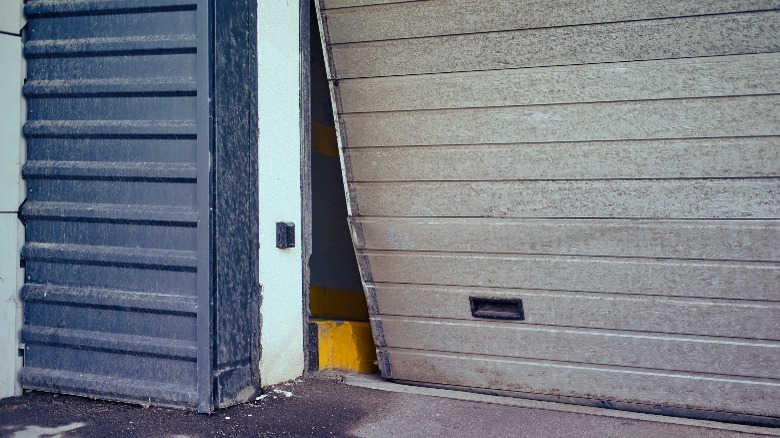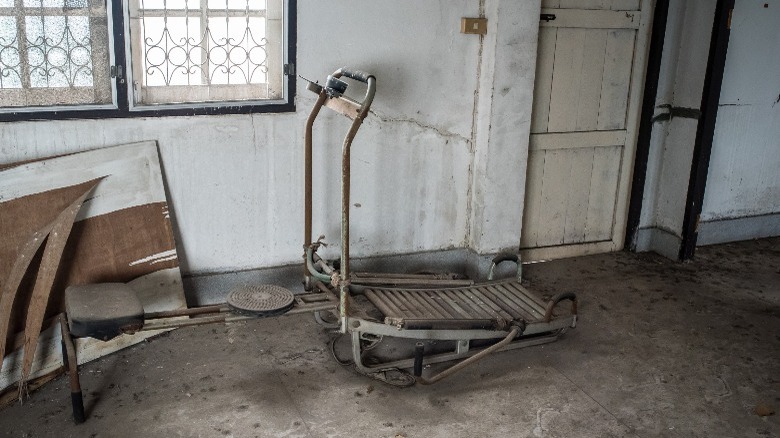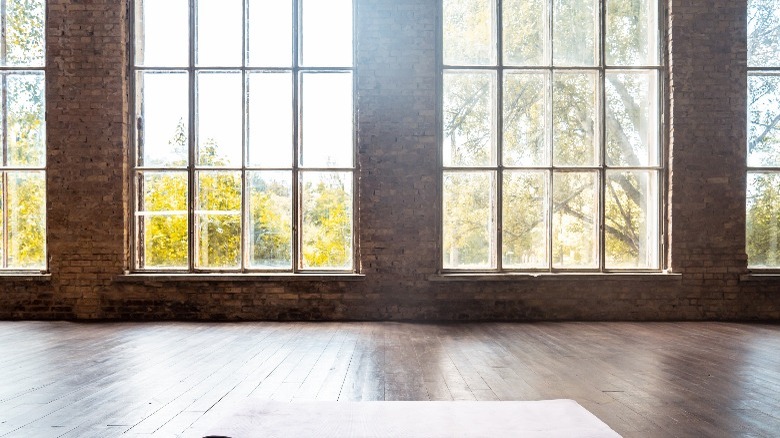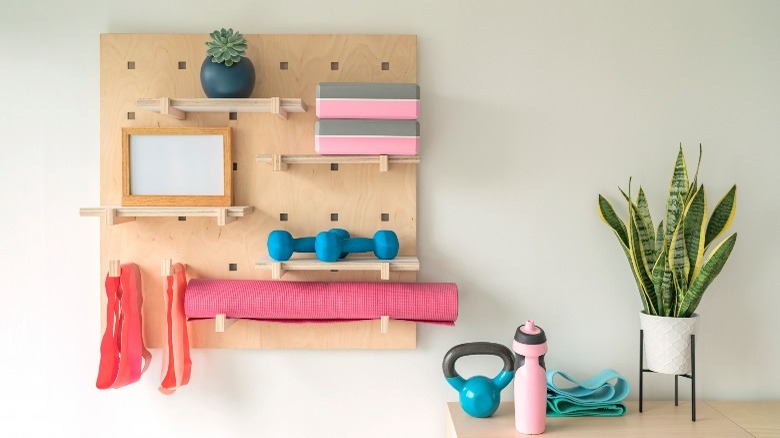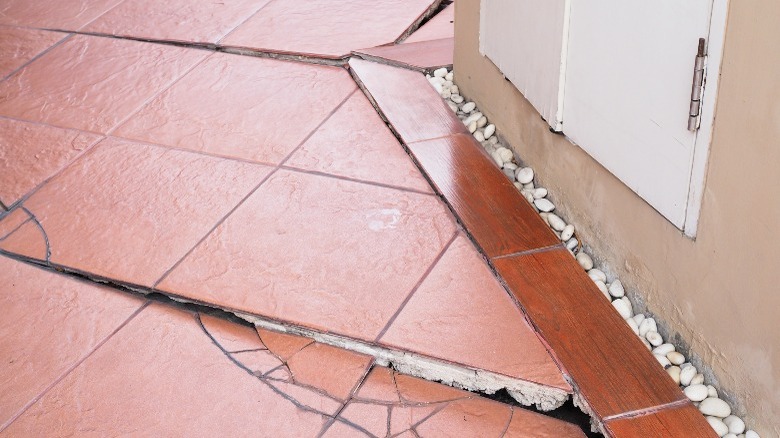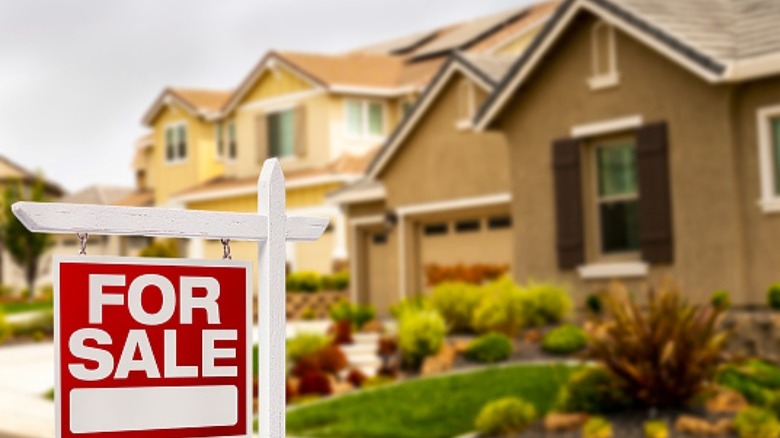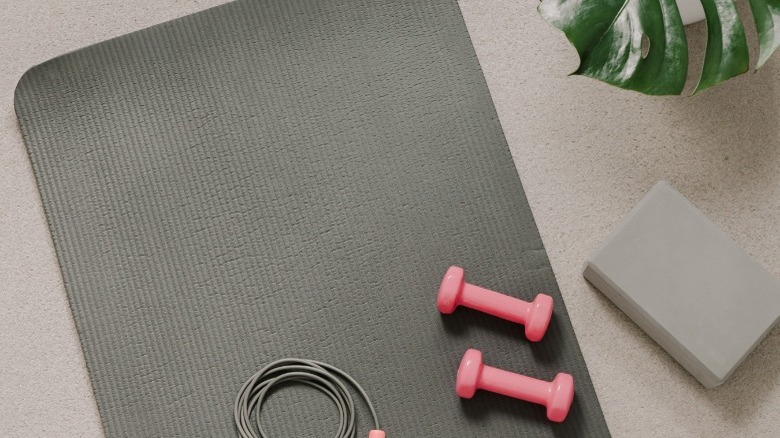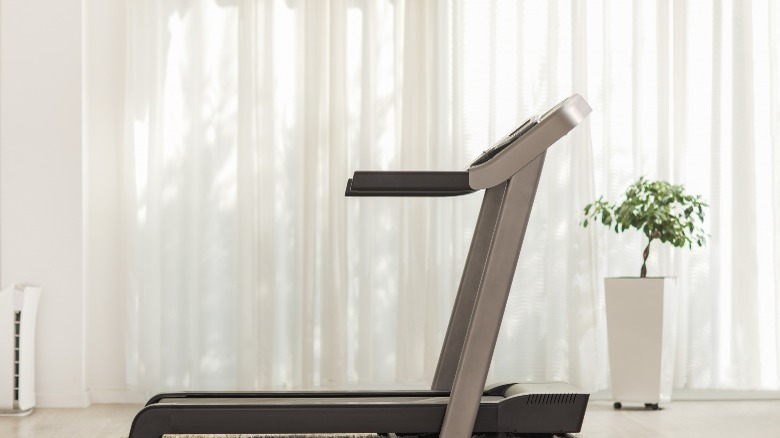The Hidden Downsides To Home Gyms
Why can athletes lift more weights than prisoners? Because the pros outweigh the cons, of course!
But is this the case with home gyms? Well, not necessarily. There are some hidden downsides to home gyms, and these may be things you hadn't thought of before. So if you're making New Year's resolutions now, you might want to join a gym instead, according to Mercury News. Here's a teaser: One reason you might not have thought of, is the fact that you won't have as many options for home gym equipment as you would at the actual gym. And not only that, but the equipment itself, can be a problem in more ways than one. If you're considering a home gym, but you still have some concerns about potential problems, you'll want to keep reading.
According to Digital Trends, the indoor air quality in your garage may not be conducive to putting a gym there, so if you were thinking about that space, it's probably not a good idea – at least not until you've put in a good ventilation system. Not only is carbon monoxide a concern, but so are other pollutants from things like airborne viruses, and dangerous cleaners or other toxic chemicals that may be stored in the garage. But there are other places to put a home gym, aren't there? Sure, but let us just say, at your own risk. These were only teasers, however, because as it turns out, there are quite a few significant disadvantages to home gyms that are certainly worth thinking about.
The cost of equipment
The average cost of a home gym is over $3,000, according to a 2021 survey, via Strong Home Gym. With the level of inflation this year, that cost is likely now much higher. Now let's take the average gym membership cost, which is listed at approximately $60 per month. This means that it would take the better part of five years in membership costs to equal that amount. But according to My Fitness Resolutions, you can expect to pay an average of $4,000, and up to $10,000 for a home gym in the basement. Talking specifically about the cost of some common home gym equipment today, The New York Times reports that the base model of a Peloton bike is going to run you around $2,000 for the first year, and another $500 for each year thereafter. This is for the ongoing subscription required to receive the streaming workout content that comes with it. But a better model will cost $2,500 just for the exercise bike, not including the subscription.
That seems like an awful lot of money for one piece of equipment. The average price of a decent treadmill is about $1,000, per Garage Gym Reviews. If you want to add a bench and weights, plan on another $1,000 – or more. Don't forget the workout mats, gear, and all the accessories that go with supplying your home gym with everything you'll need. Keep in mind that it's going to be a significant investment, and it's going to take years to pay for itself. Therefore, make sure you're committed to making the investment worthwhile if you choose to proceed.
Can damage the structural integrity of your home
If you're planning to put your home gym on the second floor, that could be a very bad idea, according to Gym Crafter. There's a danger of damaging your home's structural integrity, by opting for a second-floor home gym. Most modern, well-built homes will be fine, as long as you figure out how much weight it can take safely and don't exceed it. However, although the floor might not break through, there's other damage that can occur which might even be worse. Your floors may begin sagging or warping, and your doors and windows might not open and close right. This is because so much weight is being placed in one room as opposed to the others, that over time, structural damage is seen in various ways. The strain on the rest of the house from the one space that is your home gym might be more than it can bear.
Typically, a second-floor room can bear 40 lbs. per square foot, or 30 lbs. per square foot in bedrooms. To figure out how much load-bearing capacity your second-floor room has, take the total square footage and multiply that number by either 30 or 40, depending on which room you plan to use. The number is going to tell you how much weight you can put in the room as a whole. You still will need to distribute the weight carefully and evenly, and take extra precautions in keeping your home safe from damage. So if you have a choice, and you're still leaning towards a home gym, choose a bottom floor room or basement. The possible structural damage a second-floor gym can do is not worth the risk, as it would be very expensive to repair.
Cleaning your equipment is a necessary evil
We know your equipment doesn't look like this, but it's still an example of what neglect can become.
As we've discussed, equipment can be quite costly, and you're going to want to protect your investment. But that's only one reason you'll need to be vigilant in cleaning your equipment, whether it's a yoga mat or a treadmill, according to LiveFit. The bacteria that will thrive there otherwise, pose a significant danger to your health. Even if you are the only one using the equipment, it still needs to be properly cleaned regularly. Sweat alone has a high amount of salt, and this can damage the equipment and shorten its lifespan if you don't remove it often. And although the task of cleaning your workout equipment may not be fun, it is definitely a necessary evil. In fact, did you know that if you don't do this, it will void your warranty? That's right, so look for the fine print in the owner's manual for your exercise equipment. The exact maintenance requirements will typically be found there.
Takes up a lot of space
Of course, this is one of the major hurdles of a home gym: Finding the space. There are multiple ideas for places you can put a home gym, but practically all of them require the dedication of at least an entire room, if not a garage or basement. Besides just the square footage, there are some other things to keep in mind, according to Sports & Fitness Exchange. You'll need to put in rubber flooring if the space you choose has hardwood or cement floors. Another consideration is putting a television and DVD player and/or a stereo in the room, to help you with workouts and motivation.
You already know you'll need plenty of space for the equipment you plan to buy. Remember, you can put a home gym in various places, but you want to find a space you can make your own, that's inviting for you to spend time in. Otherwise, you'll never want to go in there, negating the entire purpose. Therefore, finding the proper space for a home gym can be a challenge, especially if you really don't have an ideal place to put it! You might have to be creative to fit your home gym into a small space.
You'll need more storage space for accessories
According to Garage Gym Lab, finding the storage space for your home gym accessories is an important aspect to think about, as well. There are various options that sometimes can be incorporated into walls and racks, but this will add to the cost of a home gym. Additionally, storage of accessories is likely to add to your space requirements, so be sure to add some room for some type of storage area. You might be surprised at the number of things that need organizing and storage for your home gym.
If you lift weights, you'll need a storage rack, and the one recommended measures 76-½ inches in length, and approximately 24" inches in depth, and you have the choice of either two or three tiers. Another option gives you a choice between a length of 49" inches or 76" inches, and a 30" inch depth. This one also has options on shelf tiers, but either way, this is another large piece of equipment that will need to be figured into space requirements.
Equipment can damage floors
We know rubber flooring is necessary for a home gym on hardwood floors, and we want to protect our floors! So can rubber flooring damage our precious wood floors? Unfortunately yes, at least in some cases, according to Flooring Inc. In these instances, the hardwood floor beneath rubber flooring can sometimes become discolored due to a chemical reaction that happens between the ingredients in the rubber, and polyurethane finishes that could be on the hardwood. If this happens, it will make the finish cloudy and can even discolor the wood beneath. But this is just one way your floors can become damaged due to a home gym.
According to Live Healthy, equipment like treadmills can cause extensive floor damage. Even lightweight machines pose a danger to flooring of any kind, and should always be placed on a specialized mat. Heavy treadmills present obvious risks to the floor, while lightweight treadmills may move around more while using them and still damage the floor, so even if you put down rubber flooring, you should invest in a specialized treadmill mat.
Could reduce your home's resale value
Though in many cases a home gym might increase home value, that's only for prospective buyers who might want one (via Realty Today)! In other words, a home gym might narrow the buyers down to those who would find it a positive. Of course, this could have a say in how completely you want to transform the space.
After all, a home gym can be a significant investment, but it's also possible to do on a smaller scale. And it doesn't have to be undoable — you can still have a home workout space with minimal equipment, and not have to do any actual remodeling, just a little rearranging. For instance, perhaps you could combine a home office space with a workout spot. It all depends on how committed you are, and what your budget is. Certainly, a gym membership has its advantages as well. If you do decide to go with a home gym, and you're worried about resale value, be sure to invest in the aesthetics.
Design mistakes
According to Realtor.com, there are several design mistakes people make when designing a home gym. These can be things like not allocating enough power for your home gym or purchasing too much equipment for the space.
Ultimately, the most common mistakes affect the aesthetics or the functionality of the room. If the space doesn't look nice, has poor air quality and insufficient lighting, and never feels like a place you want to spend time in, it won't be used as often. In the same vein, if it's crowded with equipment or underpowered, it'll be more hassle than it's worth to get in a workout.
Eliminate these design mistakes by taking stock of your available space and deciding which equipment you'll actually use. Then put in the work making the area as attractive and functional as possible when creating the perfect home gym.
Aesthetic gear costs a premium
We understand perfectly wanting to design your home gym with style and a chic flair, but having bourgeois gear isn't all it's cracked up to be, and what's more, it costs a pretty penny! According to Galerie Magazine, there's a trend of having aesthetically pleasing gear for your home gym, and of course, plenty of manufacturers to meet the demand... for a premium. And in this case, the premium is high. Take for instance a small set of weights and rack, 5-50 lbs. from Top Fitness, which costs $1,400.
is not cheap by any means, but now let's compare a small weight set in the luxury equipment department from Jack Game Room, with small weights ranging from 8.8 lbs. to 17.6 lbs. and a couple of medicine balls, on a rack, with a price tag of $7,800. Granted, this rack is made with real leather and a natural walnut or ash base and looks beautiful, but paying a price that's pushing five figures for this piece of equipment is way out of most people's league. Everyone wants their home gym to be aesthetically pleasing, but few can afford to buy the equipment that would help them achieve this.
hope you've found this helpful in making your decision on putting in a home gym. Ultimately, the decision to put in a home gym comes down to your needs, budget, available space, and fitness goals. And now you know which mistakes to watch out for!


